🎲 Games to Foster Language in Children with ASD
🧩 Introduction to Play as a Therapeutic Tool
Play is far more than just entertainment: it's a natural and powerful avenue for learning. For children with Autism Spectrum Disorder (ASD), play isn't merely a leisure activity but a key tool for developing fundamental skills, especially those related to language, communication, and social interaction.
Playing involves exploring, practicing, discovering, and sharing. Through playful activities, children can acquire new words, imitate sounds, practice conversational turns, learn to make requests, express emotions, and understand how human interactions work. This occurs even when verbal language isn't present: play allows for the development of alternative communication forms like gestures, gazes, object use, pictograms, or assistive technology.
The therapeutic use of play stems from a fundamental principle: respecting the child's style, interests, and pace. Many children with ASD feel more comfortable with repetitive, sensory, or solitary games. The key is to enter their play world with respectful support, without forcing, and with proposals that invite sharing, exploration, and connection based on what they enjoy.
Additionally, structured games allow for gradually working on objectives such as:
Stimulating verbal and non-verbal language, including sounds, words, phrases, or meaningful gestures.
Fostering comprehension of simple or sequenced instructions, helping the child follow routines, commands, or directives.
Developing basic social skills, like sharing, waiting for turns, looking at others, or responding to an action.
Expanding functional vocabulary, meaning words the child needs for daily life (food, objects, places, actions).
Increasing joint attention, which is the ability to focus on an object or activity with another person—a key step for learning to communicate.
When play is accompanied by visual supports, predictable timings, and appropriate materials, it transforms into a safe, pleasurable, and profoundly meaningful experience. That's why this MiRutaTEA section aims to offer you practical ideas, printable materials, and activities adapted to different communication levels.
Whether at home, at school, or in a therapeutic setting, play can be the first step in building bridges of language, connection, and understanding. And most importantly, to show every child that their way of communicating—whatever it may be—deserves to be heard, valued, and celebrated.
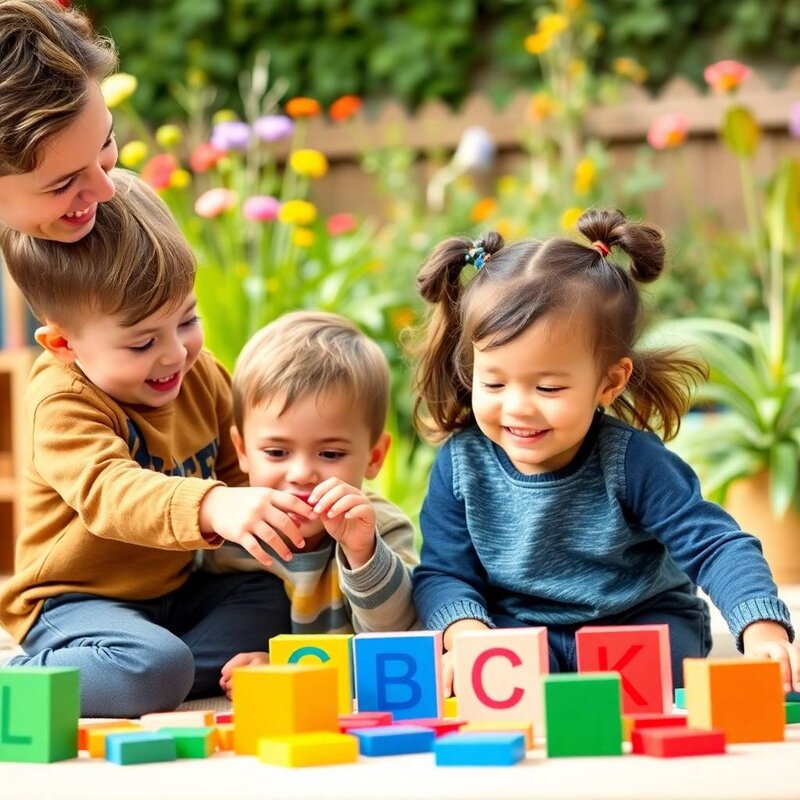

❗ Common Issues in Communicative Play
Play is far more than a pastime or entertainment; it's an essential avenue for children to understand the world, develop cognitive skills, and, above all, communicate with others. For children with Autism Spectrum Disorder (ASD), play represents a very valuable learning opportunity, yet it can also become a source of difficulties. Often, play doesn't emerge spontaneously or doesn't align with the social schemas adults expect. The child might play repetitively, not invite others to participate, not share objects, or simply seem uninterested in playing. But that doesn't mean they can't or don't want to connect: it means they need a different way to do so. That's why it's key to understand the particular challenges that can arise in communicative play, as well as to discover respectful, empathetic, and practical ways to support it. When this is achieved, every moment of play transforms into a bridge towards emotional connection, shared language, and authentic inclusion.
In this section, we present some of the most frequent problems that typically appear during play with children with ASD, along with strategies designed with respect, observation, and conscious support in mind. These proposals can be applied both at home and in educational or therapeutic settings, always adapting to each child's pace, preferences, and needs.
🧸 Problem 1: The child doesn't initiate play or show interest.
One of the first hurdles many families notice is that their child doesn't seem interested in playing, or doesn't take the initiative to start a playful activity. This can cause worry or sadness, especially when adults try to offer toys that, seemingly, should appeal to them. However, it's crucial to understand that spontaneous and symbolic play—like feeding a doll or pretending with a cup—doesn't always emerge at the same times or in the same way for children with ASD. Their way of exploring might be more sensory, repetitive, or focused on certain details that others overlook, such as spinning a wheel or lining up objects.
🔑 Solution: The first step is to observe carefully and without judgment. Pay attention to what draws their attention: it might be a flickering light, a soft texture, a particular sound, or an object's movement. From there, build small play opportunities that stem from that genuine interest. For example, if they're interested in a spinning wheel, you can spin it too and comment on what happens, or present other objects that spin. It's important to avoid imposing a type of play that doesn't feel natural to them. Instead, enter their world with curiosity and presence, validating their way of playing as a starting point. Over time, this exchange expands, and from there, language, turns, and imitation can begin to be included.
⏳ Problem 2: Doesn't sustain attention or changes activities very quickly.
Another common situation is that the child moves from one activity to another very quickly, not staying long enough in a proposal for it to become a communicative experience. This can be due to multiple factors: from low tolerance for waiting to difficulty organizing the sequence of actions needed within a game. It can also be related to sensory hypersensitivity or the need for constant movement for self-regulation.
🔑 Solution: In these cases, it's essential to offer very brief, structured games with concrete, visible goals. Proposals like fitting pieces by color, throwing a ball and saying a word, finding figures on a sheet, or following a sequence with images can be more effective than long or abstract games. Using visual supports (like pictograms or photos) to anticipate what will be done and what comes next helps organize attention and reduce anxiety. Additionally, it's important to celebrate every step achieved, even if the child plays for only a few seconds. That small shared moment is already an accomplishment that can be progressively extended. Remember that the focus isn't on "making them play for a long time," but on them feeling safe, understood, and supported during the time they can share.
🗣️ Problem 3: Doesn't repeat sounds or imitate words.
One of the most frequent goals in play with children with ASD is to stimulate verbal production, but often the child doesn't repeat the words, sounds, or gestures suggested to them. This lack of imitation shouldn't be interpreted as disinterest or defiance, but as a manifestation of the child's neurological profile, who may require more time, motivation, or alternative paths to reach that stage. They are likely observing, processing, or even imitating internally without it being immediately visible. Verbal imitation is a complex ability, involving attention, communicative intent, and emotional trust.
🔑 Solution: Instead of insisting that the child repeat words, it's best to make sounds a fun and predictable part of the game. Use puppets that make animal sounds, toys that emit striking noises, or simply play with your own voice exaggerating sounds like "boom!", "woof!", "tick-tock!". These sounds can become game-starting signals, part of a musical routine, or responses to concrete actions. For example, if you roll a car, you can say "vroom vroom!" each time, then pause, waiting for the child to complete the sequence. Even if they don't do it right away, they are receiving a clear, repetitive, and pressure-free model. In the long term, this strengthens phonological development, the desire to participate, and the understanding of language as a form of interaction, not an isolated demand.
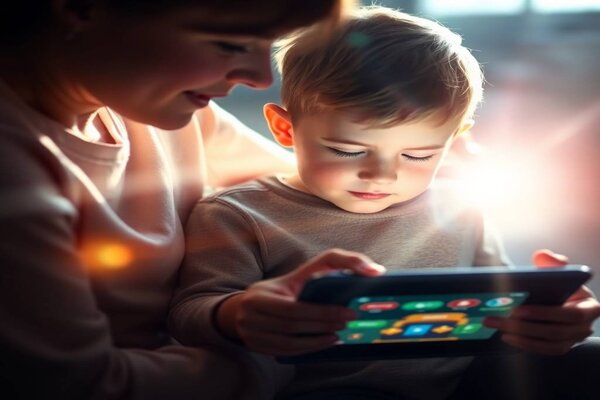

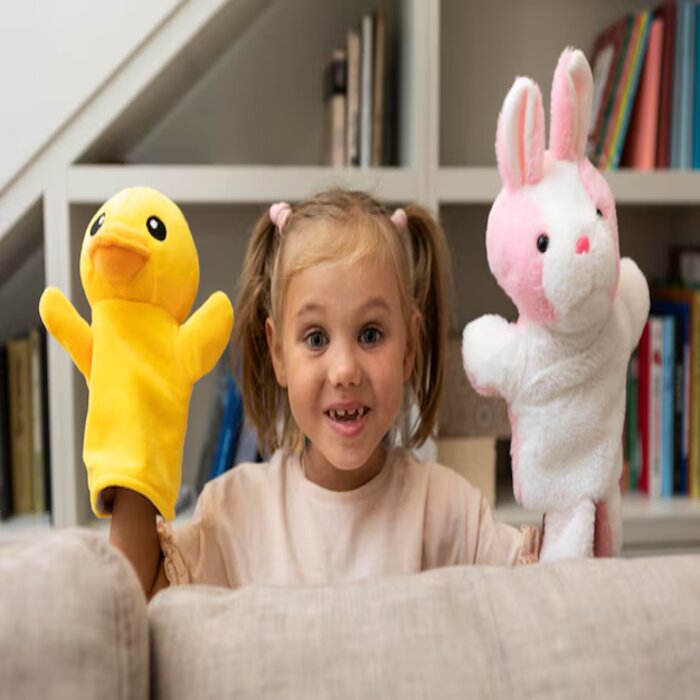

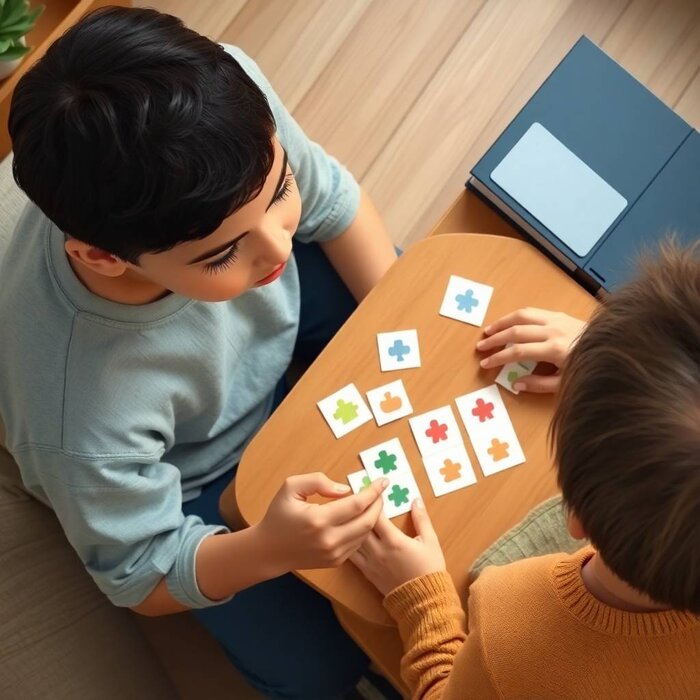



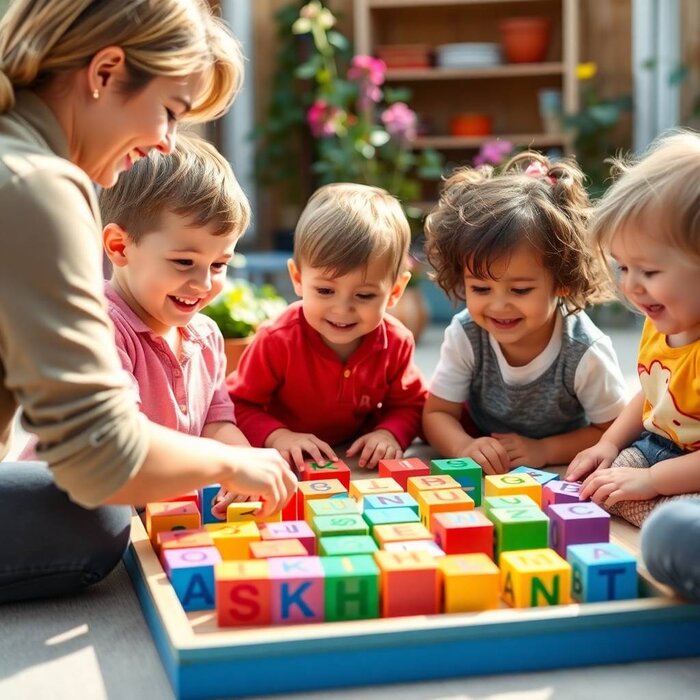

🧩 Games for Non-Verbal Children
🎯 Choice Boards & Visual Communication
Choice boards are a fundamental gateway to initiating communicative interactions in children who are not yet using verbal language. These visual resources, be they pictograms, real photos, or simple drawings, represent concrete options from the child's environment (food, toys, activities, people). The systematic use of these images allows the child to express their choices without needing to speak.
The adult presents two or more options (e.g., a pictogram of a ball and another of a tablet) and carefully observes if the child looks at, points to, or touches one. Every choice is celebrated as a valuable communicative act. If the child already uses the PECS system, they can take the card and give it to the adult, thus initiating a visual exchange that reinforces their autonomy and ability to express desires, needs, or interests. Through these dynamics, the child learns that their communication has an effect, which motivates them to repeat the action and continue learning new codes. Additionally, this method can also be implemented during daily routines: choosing clothes, breakfast, or an afternoon game, turning every moment into a communicative learning opportunity.
🤸 Action Games with Gestures: Movement as Language
The body is a powerful tool for expression when words are not yet present. Therefore, games involving gestures, body movements, and simple actions become essential allies for stimulating non-verbal communication. Activities like "Jump to the drum's beat," "Clap when we finish a round," or "Push the cart when we say three" not only bring joy but allow the child to anticipate what's coming, respond with an action, and even create communicative routines.
Every small gesture—like raising a hand, imitating a movement, making eye contact, or making a sound at the expected moment—should be validated and reinforced as a legitimate form of communication. This type of interaction helps the child feel like an active part of the game, that their responses are recognized, and that they can participate in their own way. Over time, these actions can become part of more complex games that combine music, turns, visual cues, and group dynamics, promoting social and emotional development.
🎁 Sensory Bins: An Experience of Exploration & Expression
Sensory bins are magical spaces where exploration transforms into a form of communication. These are containers filled with materials that stimulate the senses: varied textures (crinkled paper, soft fabric, rice, gel), bright lights and colors, soft sounds (like jingle bells or wind chimes), and scents (like essential oils or aromatic herbs).
When the child interacts with these objects, natural opportunities arise for them to express pleasure, surprise, disgust, or interest. The adult must be attentive to these reactions, modeling associated words or gestures: "It's cold!", "Look how it shines!", "It makes noise!". Even if the child doesn't respond verbally, they might vocalize, laugh, touch carefully, or reject an object, and all of these are valid responses indicating communicative intent. This type of activity also helps identify sensory preferences, which can guide future personalized educational or therapeutic strategies.
🗣️ Games for Limited Language
🧠 Word Dominoes: Simple Images for Naming and Learning
Word and picture dominoes are a classic adapted for language work. The tiles show clear illustrations of everyday objects (fruits, animals, transport, household items) along with their written names. The goal isn't to compete, but to jointly build a chain of tiles while naming what appears. If the child can't yet say the full word, it can be reinforced with syllables, initial sounds, or associated gestures.
Additionally, this game allows for working on sequences ("the car goes after the truck"), classifications ("all the animals together"), and simple structures ("I have a cow," "I give you the flower"). The interaction can range from naming to inventing mini-stories with the tiles: "The cow travels on the train," "The dog goes home," thus promoting creativity and linguistic development through experience.
📖 Picture Stories: Visual Narrative and Functional Language
Telling stories from pictures helps develop sequencing skills, mental organization, and verbal expression. We can use cards showing daily routines (waking up, washing face, having breakfast) and ask the child to order the actions logically. Then, the adult can narrate the story while the child acts it out or completes it with gestures and words.
Photos of the child performing these actions can also be used, which creates a stronger emotional connection and facilitates identification with the narrative. With practice, children can begin to tell the story themselves, incorporating longer phrases, details, and emotions: "Then I ate bread," "I washed my hands because they were dirty," "Mom helped me get dressed."
🎶 Songs with Actions: Integrating Word, Rhythm, and Movement
Music and movement are natural allies of language. Songs like "Head, Shoulders, Knees, and Toes" allow the child to associate words with body parts through movement. Other songs, like "Old MacDonald Had a Farm" or "The Wheels on the Bus," integrate sounds, rhythm, sequences, and gestures, creating a multisensory experience that favors imitation and anticipation.
Singing with the child, modeling movements, repeating gestures, and celebrating every attempt reinforces not only pronunciation but also auditory comprehension, memory, and social connection. If the child can't follow the full lyrics, they can clap, point, laugh, or make sounds, and all of that is part of the communicative process.
🧠 Games for Fluent Language
🎭 Role-Playing: Simulating Real Life with Creativity
Through role-playing, children put their entire linguistic repertoire into practice. Playing "store" allows using phrases like "How much does it cost?", "Give me an apple, please." In the "doctor's office," they can say "My tummy hurts," "Where's the medicine?". These everyday scenarios help consolidate grammatical structures, expand thematic vocabulary, and improve fluency.
Social skills like negotiating, yielding, asking, thanking, or comforting are also worked on. The adult can assume different characters or simply accompany, letting the child lead the story. The more realistic the objects (a box as a counter, a toy phone, a doctor's coat), the more immersive the game will be and the more language will be enriched.
🔗 Word Chain: Free Association and Thematic Vocabulary
This game stimulates semantic thinking and verbal fluency. Start with a word, like "bread," and the child must say another related one: "butter," "breakfast," "toaster." Each association is reinforced with a brief explanation: "Right, bread goes in the toaster!" This game can be done with drawings, written words, or verbally, adapting the difficulty level.
It can also be played in rounds, ideal for groups or family sessions, promoting turn-taking and active listening. Additionally, it can be used to work on specific categories (animals, foods, transport), helping the child classify and organize their mental vocabulary.
❓ Question and Answer Games: Active Comprehension
Using cards with simple questions like "What does it do?", "Where is it?", "Who has it?" allows for working not only on verbal comprehension but also on forming complete answers. With pictures, stories can be built ("What's wrong with the cat?" – "It's sleeping"), and with real objects, identification and description can be practiced ("Where's the spoon?", "What's the broom for?").
This type of game strengthens logical thinking, sentence construction, and the use of connectors. As the child progresses, more abstract or open-ended questions can be incorporated ("Why is the child sad?", "What would you do if your toy gets lost?"), promoting reflective language and empathy.
🤝 Cooperative and Social Games
🏗️ Turn-Taking Tower: Language in Action
Building a tower by taking turns with blocks, chips, or plastic cups allows for simultaneously working on language, patience, and joint attention. Each turn can be accompanied by a word: "Red," "My turn," "One more," or phrases: "I put mine on top," "Now you." This dynamic promotes emotional regulation, respect for others, and the use of language in real contexts.
The adult can introduce variations, such as challenges ("put the block without it falling"), rules ("only same colors"), or role changes. The more motivating the dynamic, the more willing the child will be to participate and speak.
🙂 Emotion Imitation: Building Verbal & Non-Verbal Empathy
Through cards with faces, expressive dolls, or simply using a mirror, emotions can be represented and practiced—how they look, feel, and are named. One can say "I'm angry" with a furrowed brow, or "I'm happy" with a big smile. Then, one can play guessing: "How do I feel now?", or invent situations that generate emotions ("The ice cream fell," "You won a gift").
This type of game helps expand emotional vocabulary, identify body signals, and begin to empathize with others—fundamental skills for effective communication.
🎒 The Magic Bag: Vocabulary, Turns, and Creativity
The famous magic bag is a flexible resource, adaptable to any age or level. It's filled with varied objects (everyday items, school supplies, toys, surprises) and the child is invited to pull one out without looking. Then, it's named, described, a story is invented, or it's shared with another. The game can vary: "What is it for?", "What body part uses it?", "What does it rhyme with?", thus fostering multiple dimensions of language.
It can also be used to work on emotions ("I pull out something I like"), classifications ("things that go in the kitchen"), or narratives ("this object appeared on a magic island..."). The child actively participates, listens to others, and creates, which profoundly enriches their language and social skills.
🌟 Recommendations for Parents & Caregivers: Supporting with Love, Patience, & Meaningful Play
Raising, supporting, and stimulating a child with communication difficulties—whether non-verbal, with limited language, or in full development—requires a great deal of sensitivity, observation, and emotional connection. It's not about rigid teaching or imposing an adult model, but about entering the child's world and building, from there, emotional and communicative bridges. Here's an extensive guide with recommendations to help you make play and interaction a valuable and enriching time for both of you.
🧠 1. Always Follow the Child's Interest, Not the Adult's
One of the most powerful principles in language stimulation and emotional connection is to follow the child's internal motivation. If a child shows interest in cars, trains, dinosaurs, or watching water drops fall into a pool, that's the way to go. Playing from what they are passionate about—even if it seems repetitive or less "educational" in an adult's eyes—allows the child to feel understood, valued, and willing to participate.
Avoid imposing games or activities with the expectation of "teaching something." Instead, discover what they like and join in with respect and curiosity.
😊 2. Always Reinforce with Genuine Praise, Affection, and Smiles
Children learn more when they feel safe, recognized, and loved. A simple "Well done!", a warm smile, or a gentle clap can have more impact than constant correction or demands. Positive reinforcement doesn't need to be exaggerated or artificial; simply validating every effort the child makes, even if they haven't yet achieved what's expected, is enough.
When children feel supported and celebrated in their small achievements, their motivation to participate, communicate, and explore increases.
🗣️ 3. Use Clear, Paced, and Modeling Language
Adults are language models: every word, gesture, or expression you use is an invitation for the child to listen, observe, and try to imitate. Therefore, it's important to speak to them clearly, with short, paused phrases, adapted to their level of comprehension.
There's no need to correct if something isn't said "right"; instead, you can repeat what the child said using a more complete or correct version, as a way to show them without pressure. For example: if the child says "water," you can reply "Yes, you want to drink water" or "How good the water tastes!". This way, you expand their language without causing anxiety or frustration.
🎲 4. Play Every Day: Minimum 10 to 15 Minutes of Quality Time, Screen-Free
Playtime with an adult is a golden opportunity to strengthen emotional bonding and stimulate development. You don't need to play for hours or use expensive or sophisticated toys. It's enough to dedicate 10 to 15 minutes daily to real interaction, screen-free, where the adult gives themselves completely: no cell phone, no distractions, with a present heart.
That special moment can include games with blocks, puppets, songs, bubbles, balls, or simply games of gazes, hide-and-seek, or rhymes. The important thing isn't the quantity, but the quality of the encounter. An authentic, face-to-face interaction has more impact than any educational video.
🔁 5. Repeat Without Boring: Routines Provide Security
Children, especially those with communicative challenges, need predictability. Playing the same thing multiple times doesn't mean they aren't learning; quite the opposite. Repetition is the basis of anticipation, comprehension, and language acquisition.
Establishing small play routines helps the child feel more confident and allows them to anticipate what's coming, participate with greater initiative, and experience a sense of accomplishment. Don't be afraid to repeat the same games, songs, or phrases: that "more of the same" can be full of invisible learnings.
💞 6. Validate Every Form of Communication, Even if Non-Verbal
Many children communicate through gestures, gazes, vocalizations, movements, or even their entire body. Recognizing these forms of expression as valid is fundamental. Don't always wait for words: if the child points, takes your hand, smiles, looks at you, or makes a sound, they are communicating.
Respond to these signals with enthusiasm, words, and actions. That validation teaches them that their voice—even if unspoken—has value, and that they can trust they will be understood.
🌈 7. Respect the Child's Pace: Not Everyone Learns the Same Way
Every child has a unique rhythm. Some progress quickly, others need more time. Avoid comparisons with siblings, peers, or cousins. Instead of looking at what's "missing," focus on what they are already achieving.
Language and communication development isn't always linear, and often there are subtle advancements that deserve to be celebrated: a more sustained gaze, a new word, greater participation in play. All are important steps towards a greater connection with the world.
👥 8. Involve the Whole Family in the Process
Stimulation doesn't just depend on the parent. Siblings, grandparents, aunts, uncles, caregivers, or teachers can and should be part of the process. The more communicative and affectionate environments the child has, the more opportunities there will be to learn.
Share these recommendations with your circle, explain how they can join in through play, clear language, and affection. When the entire network provides coherent support, the child feels more secure and sustained.
📚 9. Consult Professionals, But Make Home a Therapeutic Space
Therapy with speech therapists, psychopedagogists, or other specialists is valuable, but home is the daily setting where language and autonomy are built. Every moment of the day—bathing, dressing, eating, going for a walk—can become an opportunity to model language, play with sounds, name emotions, and strengthen connection.
Play is a form of loving therapy that is accessible to everyone. You don't need to be an expert: you need to be present, available, and willing to connect.
✨ In Summary:
Play, language, and emotional bonding nourish each other. Supporting a child on their communicative journey is a challenging but also deeply beautiful task. With respect, patience, and love, bridges of understanding can be built that transform the life of the entire family.
🌻 "It's not about teaching them to speak like others, but about helping them to be able to say what they feel, think, and need... in their own way, in their own time, with their own voice."


🔹 Heather Kuzmich
📸 America's Next Top Model contestant – a person with autism
💖 "Never let anyone tell you you can't be something just because you're different." — Heather Kuzmich
🧩 Free Resource for Families and Professionals
We're gifting you a PDF activity kit, ideal for children with Autism Spectrum Disorder (ASD). It includes cutout cards, games to stimulate attention, coloring activities, playful dynamics, and much more.
📚 This material has been compiled from various autism communities with the goal of sharing, supporting, and enriching learning through love and inclusion.
💖 Download it for free and start enjoying it today!
📥
Are you a Professional or Do You Provide Services Related to ASD?
At MiRutaTEA, we're developing a new section where therapeutic companions, psychologists, speech therapists, psychopedagogues, specialized teachers, and other professionals can showcase their services through our app and website.
🧩 What Will You Be Able to Offer?
Therapeutic services, school support, or stimulation.
Workshops, group activities, or intervention proposals.
Links to your social media or professional website.
Contact information so families can easily find you.
💙 How to Join?
We'll soon launch a low-cost monthly subscription system so you can be part of our community. In the meantime, you can complete the contact form and tell us about your work.
🚀 Join a Network Designed to Connect Families with Professionals Committed to the Inclusion and Well-being of Individuals with ASD.
🔗 One Click Makes a Difference
Follow us on social media and help us reach more families with information about autism and alternative communication.
📲 Your support means a lot! 👇
💙 At MiRutaTea, we believe in the power of every voice.
Your experience can support, inspire, and help someone feel less alone.
🧩 Click the button and join the blog: read, share, and be part of the conversation.
This space is yours too.
